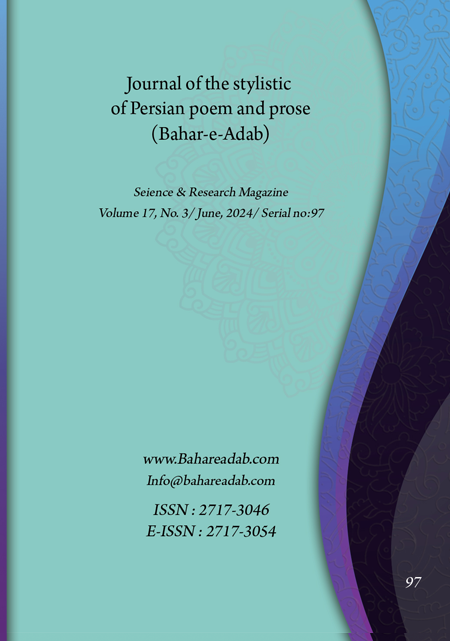- Count View : 287
- آدرس کوتاه شده مقاله: https://bahareadab.com/article_id/1647
- کد doi مقاله: Doi: 10.22034/bahareadab.2024 .17 .7328
Journal of the stylistic of Persian poem and prose
volume Number 17،
number In Volume 3،
،
issue Number 97
Differences and similarities between Attar and Rumi's storytelling styles
Reza Mohammaddoost , Reza Ashrafzadeh (Author in Charge), Mahmood Mahdavi Damghani
Abstract
BACKGROUND AND OBJECTIVES: The examination of the works of poets and literary and mystical writers of this land shows that storytelling, which is the process of using reality and narrative, to communicate with the audience, is used in a very subtle way. Sheikh Attar and Maulana are two poets who have benefited from storytelling and allegory in explaining mystical points and sending their messages many times. But despite the difference in the time period of these two poets, there are significant points of commonality and difference in their common stories and anecdotes, which require to be explored from a literary point of view.
METHODOLOGY: The research method in this research is descriptive-analytical, the data of which is collected from two Masnavas of Attar (Palehannameh, Elahinamah) with Masnavas of Rumi, during twenty common stories of these poets, by documentary and library method and by taking a survey.
FINDINGS: In this study, the influence of Rumi on Attar was completely revealed and it was concluded that, despite similarities in terms of story characters, time, place of occurrence and the style of presenting the stories, there are also differences in terms of the literary style and the way of presenting them. And from the point of view of the morphology of Molavi"s stories and the analysis of his fictional actions, it shows a more logical order that governs his stories. Therefore, in terms of innovation, Molavi"s mind is more attractive in creating expressions and concepts.
CONCLUSION: The subject of storytelling and allegory in Persian literature, especially the poems of Attar and Rumi have been of special importance, who have chosen this type of artistic format to convey ideas and remind their audience. Although Attar has a great influence on Rumi in defining his line of thought and mystical approach and teaching its teachings, Maulavi has a higher position in the art of developing stories and drawing conclusions from them, and despite the similarities in terms of the structure and content of the common stories, there are significant differences with Attar"s stories.
Keyword
story styles
, Attar
, Rumi
, features of commonality
, features of difference
, story
- Ashrafzadeh, Reza. (2012). Attar and others, Mashhad: Sokhon Gostar Publications.
- Pournamdarian, Taghi; Bameshki, Samira. (2008). "Comparison of the common stories of Masnavi and al-Tahir logic with the approach of constructivist narratology". Journal of Literary Essays, No. 165, pp. 1-27.
- Sarrami, Qadmaali. (1989). From the color of the flower to the pain of the thorn, (morphology of Shahnameh stories), scientific and cultural publications.
- Attar, Farid al-Din Mohammad (2008). Elahi Nameh, introduction, corrections and notes, Mohammad Reza Shafi'i Kodkani, Tehran, Sokhn Publishing House.
- Attar, Farid al-Din Mohammad. (1972). Tragedy, by Noorani Vasal, Tehran, Zovar Publications.
- Farhani, Sohaila. (2012). One story and four narratives (comparison of storytelling by Attar, Shams Tabrizi, Molavi and Sultan Valed in the story of Ayaz and Gohar Shekstan). Specialized Quarterly Journal of Fiction Studies, first year, second issue, pp. 67-80.
- Farozanfar, Badi Al-Zaman. (1982). Sources of Masnavi stories and parables, Tehran, Amir Kabir Publishing House, second edition.
- Farozanfar, Badi Al-Zaman. (1996). Commentary on Masnavi Sharif, Tehran, Scientific and Cultural Publishing Company, 8th edition.
- Farozanfar, Badi Al-Zaman. (2004). Molavi's biography, third edition, Tehran: Tirgan Publications.
- Kumar, Rajender. (2013). "Sheikh Attar's works and sources of Rumi's stories". Persian language and literature magazine, second year, pp. 115-128.
- Mir Sadeghi, Jamal. (1997). Story Elements, Tehran, Sokhon Publications, third edition.
- Molavi, Jalal al-Din Mohammad, (1983). Masnavi Manavi, edited by Reynolds Elaine, Nicholson, 9th edition, Tehran, Amir Kabir publishing house.
- Molavi, Jalal al-Din Mohammad, (1996). Spiritual Masnavi, corrections and annotations by Mohammad Istilami, Tehran, Zovar.

